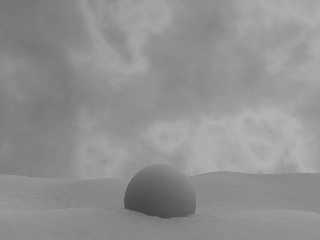 |
 |
|
 |
|
 |
|  |
|  |
|
 |
|
 |
|  |
|  |
|
 |
A couple of elements (sic) from my irtc entry.
A quick sky (single pigment_map on an inverted sphere), and no-light-source
radiosity.
A second slightly smaller sphere going from Gray25 to rgbf 1 helps fade the
light.
This scene rendered in 4 mins with aa 0.3 on p3/733
--
#macro G(D,E,F)#local I=array[3]{D,E,F}#local B=0;triangle{#while(
B<3)#while(I[B])A[mod(I[B],10)]+#local I[B]=div(I[B],10);#end<-5,-
2,9>#local B=B+1;#end}#end #local A=array[7]{x,x*2,x*4,y,y*2,y*4,z
}light_source{-x*6-z*9,1}mesh{G(105,10,146)G(105,246,10)G(105,56,
146)G(105,1256,246)G(1256,126,220)G(22156,2216,201)pigment{rgb 1}}//TM
Post a reply to this message
Attachments:
Download 'quicksky.jpg' (8 KB)
Preview of image 'quicksky.jpg'

|
 |
|  |
|  |
|
 |
|
 |
|  |
|  |
|
 |
Wonderful effect. How is it that the grey seems so warm?
Post a reply to this message
|
 |
|  |
|  |
|
 |
|
 |
|  |
|  |
|
 |
yeah, it's almost like a hot, hellish Venusian atmosphere.
nice though!
Gary W. Chmura
Tom Melly wrote:
> A couple of elements (sic) from my irtc entry.
>
> A quick sky (single pigment_map on an inverted sphere), and no-light-source
> radiosity.
>
> A second slightly smaller sphere going from Gray25 to rgbf 1 helps fade the
> light.
>
> This scene rendered in 4 mins with aa 0.3 on p3/733
>
> --
> #macro G(D,E,F)#local I=array[3]{D,E,F}#local B=0;triangle{#while(
> B<3)#while(I[B])A[mod(I[B],10)]+#local I[B]=div(I[B],10);#end<-5,-
> 2,9>#local B=B+1;#end}#end #local A=array[7]{x,x*2,x*4,y,y*2,y*4,z
> }light_source{-x*6-z*9,1}mesh{G(105,10,146)G(105,246,10)G(105,56,
> 146)G(105,1256,246)G(1256,126,220)G(22156,2216,201)pigment{rgb 1}}//TM
>
> [Image]
Post a reply to this message
|
 |
|  |
|  |
|
 |
|
 |
|  |
|
 |




![]()